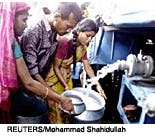The United Nations will seek international aid to help people in South Asia recover from month-long floods that have washed away rice crops, villages and livestock, and killed 1,338 since mid-June.
Until yesterday, government officials in Bangladesh had refused to call for international help, claiming their own relief efforts were enough. But several large non-governmental organizations have convinced them to reconsider.
Torrential monsoon rains and melting snow from the Himalayas have engulfed two-thirds of Bangladesh and large parts of neighboring India, causing deaths in Pakistan and Nepal, Associated Press writer Farid Hossain reports.
Flooding and related problems – many related to the lack of clean drinking water and overflow of raw sewage – have killed 768 people in India, 113 in Nepal and five in Pakistan, according to reports by officials compiled by The Associated Press.
The scarcity of drinking water has turned acute as most wells have been flooded and rendered unusable over the past week. Some relief centers are offering clean drinking water, but the demand far outweighs the supply.
In Bangladesh, the floods have killed 452 people and marooned or displaced up to 30 million people, the Food and Disaster Ministry said Thursday.
The worst floods in six years have overwhelmed this nation as relief workers struggled to get supplies to millions of people packed into temporary shelters in schools, on boats or on river embankments.
"The United Nations ... will embark on preparations for an international appeal in response to the severe flooding in Bangladesh," said a U.N. press release issued in Dhaka.
The formal appeal will go out within weeks after an assessment of the damage and needs, said the statement. The statement was issued a day after Prime Minister Khaleda Zia finally admitted that Bangladesh can't cope alone with the devastation.
Galib Mahmud, in a white school shirt, waded barefoot through waist-deep, filthy floodwaters, carrying a backpack on his head and dangling his black shoes in a string bag as he trekked across streets of Dhaka on Wednesday. "I have to go to school," the 12-year-old told Hossain.
While many public schools have canceled classes and converted the buildings into shelters, private institutions such as Galib's remain open. Up to 125,000 displaced people now are living in 160 flood shelters in Dhaka – a city of 10 million.
More than 40 percent of Dhaka is flooded, and residents have been moving in with relatives in drier areas, taking refuge in shelters at multi-storied buildings, or camping out on raised sidewalks along major roads.
Source: The Associated Press, BBC News, Reuters


